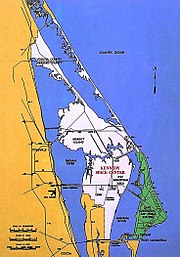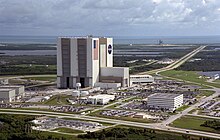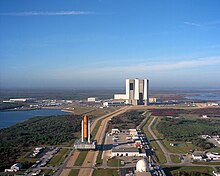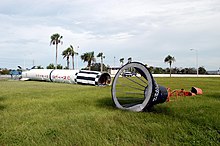Kennedy Space Center
| John F. Kennedy Space Center | |
|---|---|
 | |
 | |
| Aerial view of KSC Headquarters looking south | |
| Agency overview | |
| Formed | July 1962 |
| Preceding agencies | Launch Operations Directorate Launch Operations Center |
| Jurisdiction | U.S. federal government |
| Headquarters | Merritt Island, Florida 28°31′26.608″N 80°39′3.055″W / 28.52405778°N 80.65084861°W |
| Employees | 13,500 (2008) |
| Annual budget | $217 million USD (2008) |
| Agency executives | Robert D. Cabana, director Janet E. Petro, deputy director |
| Parent agency | NASA |
| Website | |
| NASA KSC home page | |
| Map | |
 | |
| KSC shown in white; CCAFS in green | |
Located on Merritt Island, Florida, the center is north-northwest of Cape Canaveral on the Atlantic Ocean, midway between Miami and Jacksonville on Florida's Space Coast. It is 34 miles (55 km) long and roughly 6 miles (10 km) wide, covering 219 square miles (570 km2). A total of 13,500 people worked at the center as of 2008.[3]

The KSC Industrial Area, where many of the center's support facilities are located, is 5 miles (8 km) south of LC-39. It includes the Headquarters Building, the Operations and Checkout Building and the Central Instrumentation Facility. KSC is also home to the Merritt Island Spaceflight Tracking and Data Network station (MILA), a key radio communications and spacecraft tracking complex. The center operates its own short-line railroad.
KSC is a major Central Florida tourist destination and is approximately one hour's drive from Walt Disney World and other theme parks in the Orlando area. The Visitor Complex offers public tours of the center and adjacent Cape Canaveral Air Force Station. Because much of the installation is a restricted area and only nine percent of the land is developed, the site also serves as an important wildlife sanctuary; Mosquito Lagoon, Indian River, Merritt Island National Wildlife Refuge and Canaveral National Seashore are other features of the area. Center workers can encounter Bald Eagles, American alligators, wild boars, Eastern Diamondback rattlesnakes, Florida panthers and Florida manatees. KSC is one of ten major NASA field centers, and has several facilities listed on the National Register of Historic Places.
Contents[show] |
[edit] History
Kennedy Space Center was created and has evolved to meet the changing needs of America's manned space program, initially in competition with the Soviet Union. What is today KSC was authorized in 1958 during the administration of President Dwight D. Eisenhower. The facility was originally known as the Launch Operations Directorate (LOD), reporting to the Marshall Space Flight Center in Alabama.[edit] 1960s
President John F. Kennedy's 1961 goal of a lunar landing before 1970 led to an expansion of NASA operations from a few buildings in the Industrial Area of Cape Canaveral Missile Test Annex (later Air Force Station), notably Hangar S, to Merritt Island. NASA began land acquisition in 1962, buying title to 131 square miles (340 km2) and negotiating with the state of Florida for an additional 87 square miles (230 km2).[4] The major buildings in KSC's Industrial Area were designed by architect Charles Luckman.[5]On July 1, 1962, the site was renamed the Launch Operations Center, achieving equal status with other NASA centers; and on November 29, 1963, the facility received its current name by Executive Order 11129 following Kennedy's death.[6]
[edit] Mercury and Gemini
The more complex two-man Gemini spacecraft, and its Titan II booster, based on the military ICBM, helped carry out rendezvous and docking and extra-vehicular activity missions critical for Apollo. Twelve Gemini missions were launched from Cape Canaveral's LC-19, the last ten of which were manned. The first manned flight, Gemini 3, took place on March 23, 1965. The final flight, Gemini 12, launched on November 11, 1966.
[edit] Apollo
[edit] Launch Complex 39

From 1967 through 1973, there were 13 Saturn V lift-offs, including the ten remaining Apollo missions after Apollo 7. The first of three unmanned flights, Apollo 4 (Apollo-Saturn 501) on November 9, 1967, was also the first rocket launch from KSC itself. The Saturn V's first manned launch on December 21, 1968 was Apollo 8's lunar orbiting mission. The next two missions tested the Lunar Module: Apollo 9 (earth orbit) and Apollo 10 (lunar orbit). Apollo 11, launched from Pad A on July 16, 1969, made the first Moon landing on July 20. Apollo 12 followed four month later.
[edit] 1970s
From 1970–1972, the Apollo program concluded at KSC with the launches of missions 13 through 17. On May 14, 1973, the last Saturn V launch put the Skylab space station in orbit from Pad 39A. Pad B, modified for Saturn IBs, was used to launch three manned missions to Skylab that year, as well as the final Apollo spacecraft for the Apollo-Soyuz Test Project in 1975.In 1976, the VAB's south parking area was the site of Third Century America, a science and technology display commemorating the U.S. Bicentennial, also when the U.S. flag was painted on the building. During the late 1970s, LC-39 was reconfigured to support the Space Shuttle. Two Orbiter Processing Facilities were built near the VAB as hangars with a third added in the 1980s.
[edit] 1980s–2000s: Space Shuttle
KSC's 2.9 mile (4.6 km) Shuttle Landing Facility (SLF) is the orbiters' primary end-of-mission landing site, although the first KSC landing did not take place until the tenth flight, when Challenger completed STS-41-B on February 11, 1984; the primary landing site until then was Edwards Air Force Base in California, subsequently used as a backup landing site. The SLF also provides a return-to-launch-site (RTLS) abort option, which has not been required.
After 24 successful shuttle flights, Challenger was torn apart 73 seconds after the launch of STS-51-L on January 28, 1986; the first shuttle launch from Pad 39B and the first U.S. manned launch failure, killing the seven crew members. An O-ring seal in the right booster rocket failed at liftoff, leading to subsequent structural failures. Flights resumed on September 29, 1988 with STS-26 after extensive modifications to many aspects of the shuttle program.
On February 1, 2003, Columbia and her crew of seven were lost during re-entry over Texas during the STS-107 mission (the 113th shuttle flight); a vehicle breakup triggered by damage sustained during launch from Pad 39A on January 16, when a piece of foam insulation from the orbiter's external fuel tank struck the orbiter's left wing. During reentry, the damage created a hole allowing hot gases to melt the wing structure. Like the Challenger disaster, the resulting investigation and modifications interrupted shuttle flight operations at KSC for more than two years until the STS-114 launch on July 26, 2005.
The shuttle program has also experienced five main engine shutdowns at LC-39, all within four seconds or less before launch; and one abort to orbit, STS-51F on July 29, 1985. Shuttle missions during nearly 30 years of operations have included deploying satellites and interplanetary probes, conducting space science and technology experiments, visits to the Russian MIR space station, construction and servicing of the International Space Station, deployment and servicing of the Hubble Space Telescope and serving as a space laboratory. The shuttle is scheduled to be retired from service in 2011 after 134 launches.
On October 28, 2009, the Ares I-X launch from Pad 39B was the first unmanned launch from KSC since the Skylab workshop in 1973.
[edit] 2010s
The planned end of the Space Shuttle program in 2011 is expected to produce a significant downsizing of the KSC workforce similar to that experienced at the end of the Apollo program in 1972. LC-39 would be the launch site for the Ares I and Ares V rockets, which could carry the manned Orion spacecraft by mid-decade if NASA's Constellation program were implemented; although the Obama administration has budgeted instead for a new manned booster developed by the private sector to ferry astronauts into Earth orbit.[7][edit]
NASA's first launch, Pioneer 1, came on October 11, 1958 from Cape Canaveral LC-17A using a Thor-Able booster. The civilian agency has used launch pads at Cape Canaveral AFS ever since for many unmanned launches ranging from satellites to lunar probes, including the Ranger, Surveyor and Lunar Orbiter series during the 1960s.NASA has also launched communications and weather satellites from Launch Complexes 40 and 41, built at the north end of the Cape in 1964 by the Air Force for its Titan IIIC and Titan IV rockets. From 1974–1977 the powerful Titan IIIE served as the heavy-lift vehicle for NASA, launching the Viking and Voyager series of planetary spacecraft and the Cassini–Huygens Saturn probe from LC-41.
NASA currently uses two Cape Canaveral pads: SLC-41 for the Atlas V and SLC-37B for the Delta IV, both for heavy payloads.
[edit] Weather
In October 2004, Hurricane Charley caused an estimated $700,000 in damage to KSC. On September 7, 2004, Hurricane Frances directly hit the area with sustained winds of 70 miles per hour (110 km/h) and gusts up to 94 miles per hour (151 km/h), the most damaging storm to date. The Vehicle Assembly Building lost 1,000 exterior panels, each 3.9 feet (1.2 m) x 9.8 feet (3.0 m) in size. This exposed 39,800 sq ft (3,700 m2) of the building to the elements. Damage occurred to the south and east sides of the VAB. The shuttle's Thermal Protection System Facility suffered extensive damage. The roof was partially torn off and the interior suffered water damage. Several rockets on display in the center were toppled.[11] Further damage to KSC was caused by Hurricane Wilma in October 2005.






